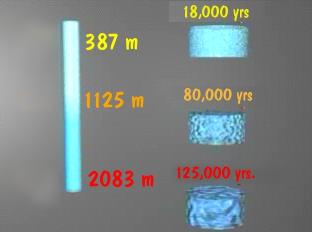Only two ice sheets remain today, one over most of Greenland and one over Antarctica. Combined they hold about 95% of all the worlds ice and hence about 95% of all fresh water stored in ice.
The sheets can run up to 3000 km thick. nearly 2 miles thick.
Temperate Glacier: ice is at the temperature-pressure equilibrium point and thus water and ice coexist.
Polar Glaciers: are in regions where the temperature never gets above the freezing point, and thus the glacier exists only as ice.
Glaciers must always form above the snowline. (snowline: point at which there is year round snow.) Makes sense, if not, then the temperature would insure water and we would see a stream rather than an ice flow.

Snow flakes melt and evaporate consolidating the water. Eventually the water draws up into a compact mass. Snowflakes have a density less than 1/10 that of water. They are highly porous as they reach the ground.
They start their earth bound existence almost like a sedimentary rock building up on the surface and consolidating themselves. By reducing their pore volume and recrystallization they become part of the solid glacier.
A glacier is classified as a metamorphic rock. It is similar to quartzite in that it is built-up of interlocking crystal grains.

Glacier ice shares roughly the same density as regular ice and thus will float on water. Core samples taken in deep glaciers show an increase in crystal size with increasing depth.
This mirrors the physical processes often seen when a sandstone is buried and undergoes normal metamorphic processes. The grain size her also grows in size with depth, heat and pressure.
| NEXT | TOC | PREV |